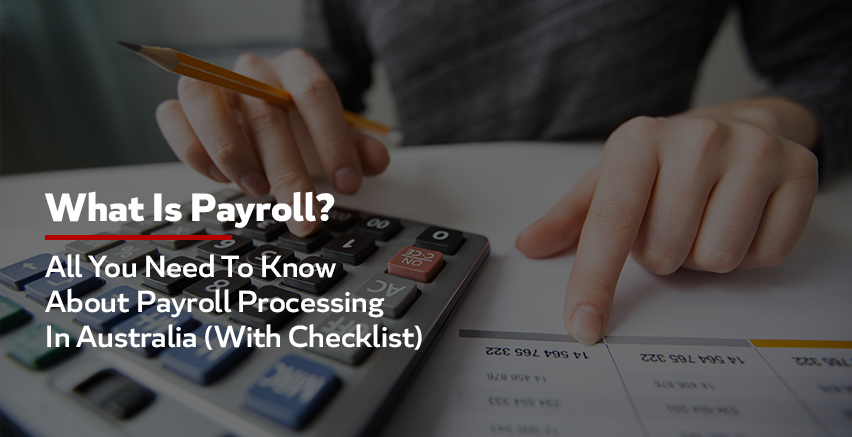
Do you own a business? Does your company have multiple people working for you? Then according to the legal requirements, they are eligible for compensation –usually monetary, for the effort and time they spend for your company. However, it is not the mere salary. You have to consider their billable hours, fill out certain forms from the federal and state revenue authorities, consider and pay the taxes, calculate deductions, and then pay their appropriate amount. In short, you have to create and include them in your business’s payroll.
So, now the most obvious question will be – what does payroll mean?
It is simply the financial compensation a business must pay its employees for a specific period or on a given date. The accounting and HR department handles payroll for established businesses, whereas the owner or their associate may handle it in small businesses. It has many components and can be complex in calculating. Payroll is a major expense for any business. However, it is tax-deductible, which means that a business owner can subtract it from the gross income and lower their taxable income. It can vary between periods because of sick pay, overtime, and different variables.
As mentioned earlier, payroll responsibilities can be complex, and the appropriate authority must complete them without error. So, the responsibilities of an employer come down to five elementary duties – irrespective of the complexities of the job:
It is better to develop a system – which should include the processes required in case of a new addition to the company payroll (new hire), standardized protocols for tax agencies, and the actions required for a payday.
Any business having paid personnel has to hold back taxes from the employees’ remunerations and pay the required state, federal, or local taxes. There are specific classes of taxes that are allowed to be withheld from the employees’ salary, such as:
Incidentally, the owner’s salary will also be subjected to such withholding if they own a small incorporated business with no external employees – as, in this particular setting, they stand as the single employee of the corporation.
The employer will need to tender estimated taxes on self-employment income each quarter if there are no employees and the business is not incorporated. So, to calculate the amount of payroll taxes, you would need to calculate the number of taxable workers, the number of taxable wages, and the withholding amounts.
The tax agencies can levy heavy fines and penalties to businesses that have failed to pay taxes or have missed a payment. Therefore, it is essential to calculate the amount of payroll taxes and pay them on time.
Nowadays, small business owners are encouraged to use single touch payroll. Now, it is normal to have the question: what is single touch payroll?
Single touch payroll is a regulation of the Australian Taxation Office (ATO) that has simplified the reporting of payroll activity. Earlier, small businesses had to produce the following documents every year:
The business owners or their associated departments can now send these reports on every payday in a specific digital format to the ATO online. This system of PAYG tax reporting is called single touch payroll.
Likewise, the answer to the general query of “what is STP reporting?” is the information the business owners can now send to the ATO every payday online in a specific digital format. The ATO uses STP reports as the entire record of income/salaries paid, taxes collected, and superannuation subsidized – making the production of payment summaries redundant.
It works just like the tax reporting through paper forms at the end of each financial year – except that now you have to submit the payroll reports online using a particular format called the Specific Business Reporting (SBR). The ATO will consider these reports the sole record of salaries paid, investments in superannuation, and taxes paid. There are mainly three ways you can send these reports online:
If you are not comfortable with digital STP reporting, hiring an experienced bookkeeper or accountant who knows payroll software is better.
STP has several benefits, making financial reporting much easier to handle and freer from errors. The following are some of the benefits of STPs used in small businesses:
Proprietors with 1–4 workers are authorized to use ATO – recommended no-cost or low-cost solutions, which cost AUD 10 monthly or less.
Pay as you go (PAYG) was introduced to make the tax payment easier for Australian business owners. There are mainly two divisions in this system:
You can pay your income tax in instalments if your business and investment income reach a certain amount. The payment frequency is usually once in three months and helps avoid a large tax bill after you lodge the income tax return. Incidentally, you still have to lodge an annual tax return even if you pay with PAYG instalments.
You have to withhold certain taxes from your employees’ salary at the time of payment – which you must send to the ATO. The employees can claim against this amount you are withholding on your employees at the end of every financial year. Except for your employees, you may have withheld payments to other contractors linked with your business and businesses refusing to share their Australian Business Number (ABN) with you.
Payroll processing is an important part of an organization and can affect the work culture, recruitment and retention rates, and employee satisfaction. Small and medium businesses must consider the needs of the company and the employee requisites before deciding on the payment processing methods. The commonest payroll processing methods utilize one of the four scheduling periods – namely, monthly, semi-monthly, bi-weekly, and weekly. However, four general factors play a major role in this decision:
Organizations should consider the different processing costs when selecting a pay schedule and payroll system – because running a payroll system costs money.
HR should think through calculating benefits deductions per pay period. For example, if an organization takes away insurance benefits monthly for the premium payment, both the employer and the employee must know the deduction date.
State legislature often dictates a minimum pay period, or at least a specific frequency of payment – and this varies from state to state. Some states allow a semi-monthly pay period as their minimum requirement, while others have a mandatory weekly minimum pay period.
According to federal laws, employers must calculate overtime every week. When running payroll, an organization with a semi-monthly pay schedule will have to consider the overtime implications of the hourly employees.
The organization should decide the payroll processing methods according to the abovementioned factors and the type of employees they work with. Each of the payroll processing methods has some pros and cons. For example, weekly pay schedules are perfect for hourly employees or workers without a regular schedule, but the processing cost is higher.
Likewise, businesses primarily using independent contractors may benefit from a monthly schedule. So, the employer organization should consider all factors and decide on the payment processing method.
Mistakes mustn’t occur, at least during in–house payroll management, because the revisions, superannuation calculation, and the compliant remuneration will significantly affect the bottom line. In that case, the company will suffer a severe decline in its services and products, adversely affecting the bottom line.
There are now several external concerns about who takes upon payroll management for you. Although their services may seem wholly beneficial at first; so, let us look at the pros and cons of internal and outsourced payroll activities in the table given below:
| Factors to consider | Payroll management types | |
| Internal payroll management | Outsourced payroll activities | |
| Processing costs | The companies incur more costs because of the direct and indirect labour charges, training costs, software subscription fees, travel and consumables for off-site courses, and temporary cover for the absent employee. | The outsourced companies charge flat-rate setup and service fees and provide data management, transfer, and provide data and reports check. |
| Taxation skills | Without knowledgeable staff about the taxation regulation, compliance, or software with in-built payroll legislation interpretation – processing payroll internally for each cycle is difficult, costly and time-consuming. | As the outsourced payroll management companies have informed and experienced staff – it is easier and cost-effective to utilize their skills. However, the client will have to manage the time, leave, and attendance data and prepare the tax reports. |
| Access to data | The internal payroll system will allow complete and unrestricted access to all payroll data. | The payroll system determines the clients’ access to payroll, reports, and employee data. In most cases, clients do not get access to the payroll engine. |
Management of payroll and keeping it error-free is not a mean task, and Outsourcing is an effective option for a business unable to afford in-house payroll experts. However, businesses with knowledgeable work staff should go for the DIY approach – as it provides complete access to the data, better security, and peace of mind. If you are thinking of the troubles and cost to design in-house payroll software, there are several programs available for use now.
Read More on: What To Choose Between Internal And Outsourcing Payroll
Payroll software systematizes every phase in the payroll procedure for small to large businesses. It manages the payment for the employees by making the process of setting up direct accounts, withholding payroll taxes, keeping correct records easy – and saving the business from hefty fines. Here is some software that is used by leading businesses in the field:
It offers more than 160 reports for salaries, taxes, revenue, and more. It also spontaneously files the payroll taxes, confirms agreement, and includes incorporations with effective programs such as accounting and benefits apps.
It offers direct deposits or checks for employee payment. Gusto also trails and files federal, state, and local taxes spontaneously. It offers an improved plan for each upper tier. High-tier plans get next-day direct deposit which needs four days to clear for the lowest plan.
It is one of the most stress-free online payroll services available. It has a clear main menu and an intuitive dashboard. “Work” provides an easy setup and a tutorial explaining the services lucidly. It also has a time-clock to log in and record their work hours.
You can also choose among payroll software like ADP, OnPay, QuickBooks Payroll etc.
Running payroll for a business is a lot more than just writing checks. The employer has to follow different regulations and requirements, fill out the needed forms, understand the complicated tax laws, and many more. Many of the new business proprietors become overwhelmed with all these complexities. It often seems that there is no straight answer to the question “how to set up payroll for small business?”
However, the process isn’t as complicated as it looks. Experts have divided the job of setting up a payroll into certain activities – which you need to complete to set up the payroll for your small business successfully. Here are the activities listed below:
The business owners can hire an accountant, use payroll software, or do it themselves. Whatever the method, the calculation and disbursement of salary and taxes have to be error-free and timely. The ATO levies hefty fines on error-filled or late payments. Likewise, you have to decide on the mode of payment: direct deposit, cash, or any other method. It is better to consult with an informed professional to set up the payroll account or hire established companies properly.
You will need the following documents to set up a payroll for your business in Australia:
The employer would also need to keep proof of providing a superannuation standard choice form.
Payroll processing can be a terrifying chore – mostly because of the pressure of adding the correct information every time coupled with keeping all the relevant records. In addition, the business owner may have to opt for PAYG over a certain earning limit. These are why companies prefer to outsource their payroll service and opt for different payroll software. So, here is a compact checklist for the individual attempting to complete this daunting task:
You can identify and amend any mistakes made throughout the financial year by using an unscheduled pay run in the payroll software. You have to create the pay run for the needed time and input the adjusted amounts. Some software allows the inclusion of negative values. Before reporting the pay run, ensure that the financial year is correctly entered. The finalization screen may take some time to update if you are using an STP, so you may have to wait until it does.
So, here is the information you may require for Australian payroll processing for 2022. Use them to pay your employees and file your returns correctly.



Copyrights © Palladium Financial Group 2024